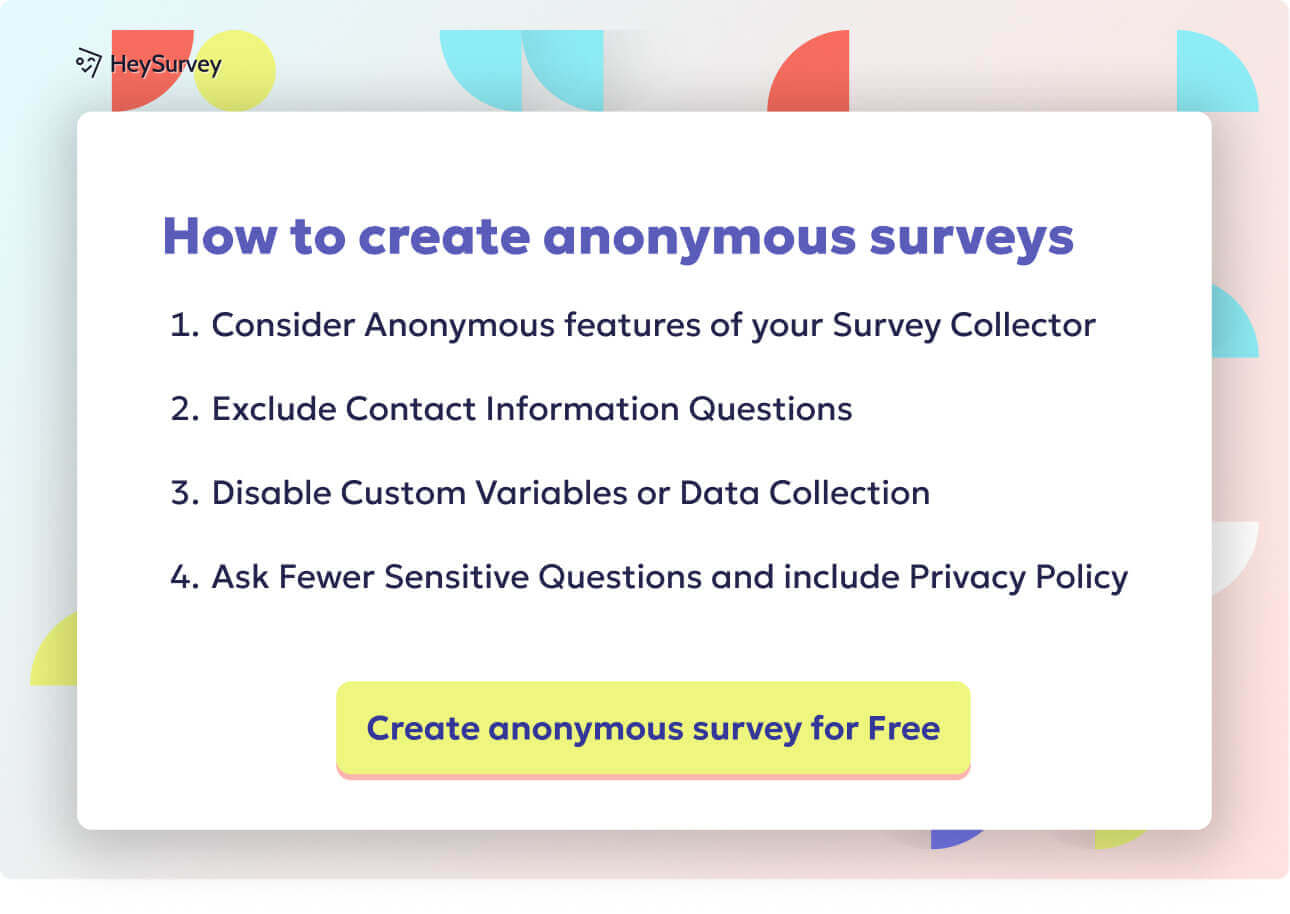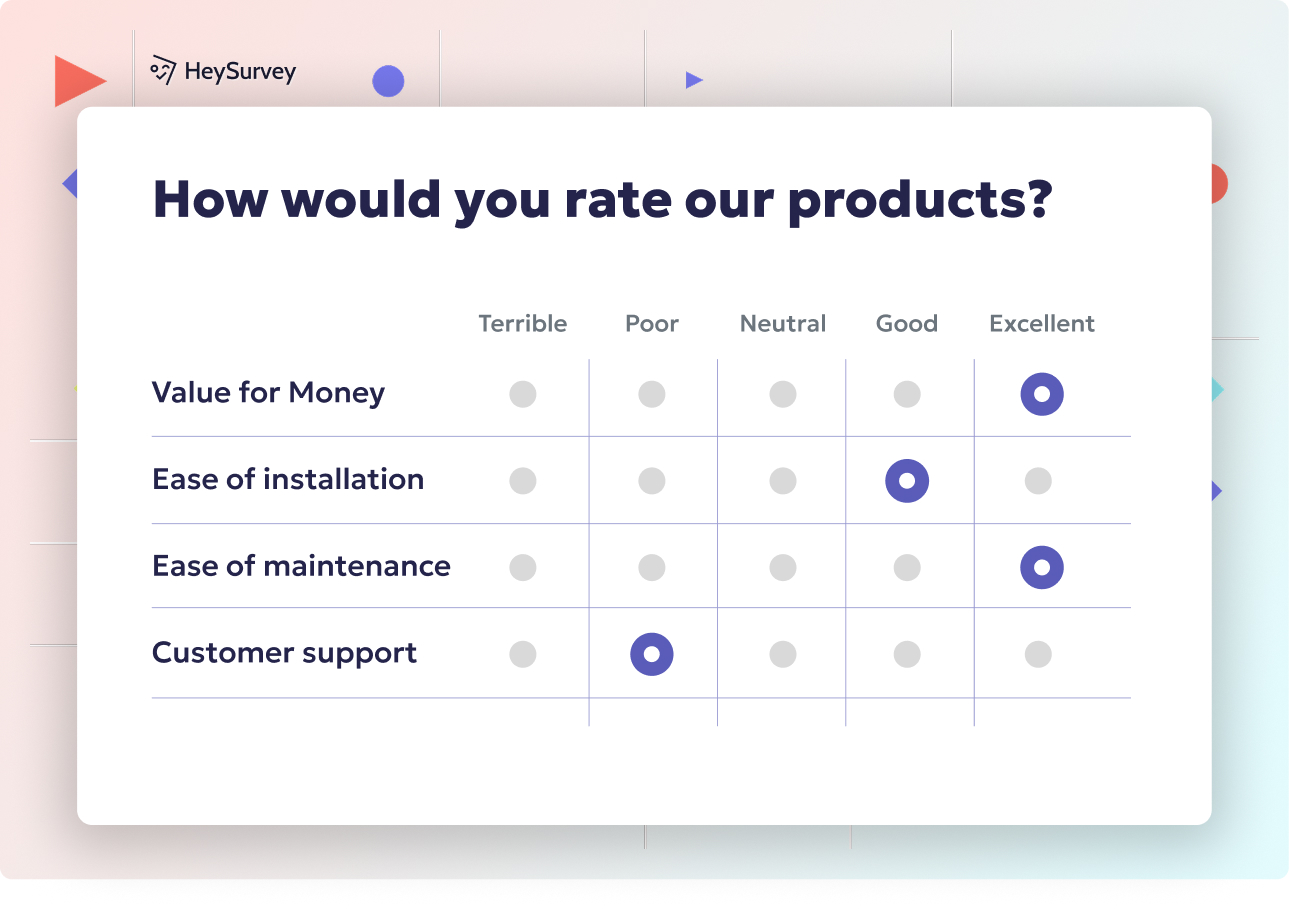29 School Survey Questions for Better Student & Staff Feedback
Discover 30+ effective school survey questions across categories like student, parent, teacher, and climate surveys to boost engagement and improvement.
Every school wants to know what their community is thinking, but mind reading hasn’t quite been added to the curriculum yet. That’s where the power of well-designed school surveys comes in! School surveys help K-12 and higher-ed institutions get direct feedback from students, parents, and staff to drive meaningful change. Whether it’s the end of a term check-in or a quick pulse survey during new program launches, these surveys give schools actionable insights. In this article, you’ll discover the most impactful types of school surveys, see targeted question examples, and walk away with essential tips for creating surveys everyone actually wants to answer.
Student Satisfaction Surveys
Getting to the Heart of the Student Experience
It’s impossible to improve student experience if you don’t listen to student voices. That’s why student satisfaction surveys are essential for schools determined to put learners first. These surveys are ideal for capturing real-time feedback on things like clarity of lessons, quality of resources, or how comfortable students feel seeking help.
Schools should roll out these surveys at the midpoint of each term to address concerns before report cards roll in and again at the end when memories are fresh. Think of them as a check-up on how things are going, as well as a chance for students to feel truly heard. By considering what students have to say, administrators can shift from guessing to knowing where to make tweaks that really matter.
Actionable Questions That Matter
Here are five student survey question gems to spark actionable feedback:
How satisfied are you with the clarity of your teachers’ explanations?
Which classroom resources (textbooks, tech tools, lab equipment) most enhance your learning?
Do you feel that your opinions are valued during class discussions?
On a scale of 1–10, how comfortable are you asking for academic help?
What one change would most improve your day-to-day school experience?
When students participate in surveys that value their input, you not only gather data—you build a sense of belonging.
Maximizing Student Voice for Continuous Improvement
Inviting students to help shape their experience shows commitment to continuous improvement. A few ways to supercharge your process:
- Keep survey language friendly and easy to understand.
- Consider adding open-ended questions for those who want their ideas heard.
- Swiftly share big-picture results with students and explain what you’re doing with their feedback.
Don’t let insights gather dust—act on results, and students will take future surveys even more seriously!
Student surveys provide valuable insights into teaching effectiveness, offering reliable and actionable feedback that can enhance instructional practices. (kappanonline.org)

Creating a school survey with HeySurvey is easier than you think! Whether you’re new to surveys or just new to HeySurvey, follow these three simple steps to build and launch your survey in no time.
Step 1: Create a New Survey
- Head to HeySurvey and click on Create Survey.
- Choose to start from a pre-built template (perfect for school surveys), an empty sheet, or enter questions via text input.
- Give your survey a clear internal name so you can find it easily later.
Step 2: Add Your Questions
- Use the Add Question button to start building your survey.
- Pick question types like multiple choice, scale (like Likert), or text for freeform answers—this versatility works great for student, parent, or teacher surveys.
- Customize each question’s text, mark required questions, and consider adding images to increase engagement.
Step 3: Publish Your Survey
- Click the Preview button to make sure your survey looks great on all devices.
- When you’re happy with it, hit Publish to generate a shareable link.
- Remember, publishing requires an account so you can view responses afterward.
Bonus Step 1: Apply Branding
- Upload your school logo via the Branding settings to make the survey visually consistent with your organization.
- Customize colors, fonts, and backgrounds in the Designer Sidebar to create a welcoming and professional look.
Bonus Step 2: Define Survey Settings
- Use the Settings Panel to specify start and end dates for survey availability.
- Set response limits or add a redirect URL for a thank-you page when respondents finish.
- Enable the option to let respondents view results on certain question types for extra transparency.
Bonus Step 3: Use Branching for Smarter Surveys
- Add branching logic to customize which questions a respondent sees based on their previous answers.
- This keeps surveys relevant and quick, especially useful for complex feedback like teacher or school climate surveys.
Ready to start? Click the template button below and watch your insights roll in with HeySurvey!
Parent Feedback Surveys
Why Parent Voices Matter
A school can build the world’s tallest science lab, but without parent engagement, success is tough to measure. Parents see things from a unique vantage point: they know what it feels like dealing with communications, navigating school policies, and keeping track of everything from lunch menus to homework assignments.
Schools should deploy parent feedback surveys after report cards go home, post parent-teacher conferences, or at least once a year. This creates space to understand family satisfaction with school-home communication, curriculum alignment, and the school’s response to safety. When families are part of the conversation, everyone wins.
Example Questions for Parent Feedback
Try these parent feedback survey questions to encourage genuine and actionable responses:
How effectively does the school communicate important information to you?
How confident are you in the school’s safety procedures?
Does the curriculum meet your child’s academic needs and interests?
How accessible are teachers and administrators when you have concerns?
What additional resources or programs would you like the school to offer?
Creating a Two-Way Dialogue
Listening to parents unlocks a treasure trove of insights and helps schools foster a collaborative spirit. To make surveys friendly:
- Frame questions clearly, avoiding jargon.
- Make surveys mobile-friendly for those on the go.
- Communicate the changes you make after gathering parent feedback.
The best way to build trust? Show families their suggestions don’t just vanish into a survey black hole.
Implementing parent feedback surveys can significantly enhance school-home communication and increase parental engagement, leading to improved student academic success. (pubmed.ncbi.nlm.nih.gov)
Teacher Engagement Surveys
Unlocking the Staff Perspective
Behind every energetic classroom is a teacher with thoughts on teacher engagement data! Teacher engagement surveys are key for leaders interested in professional growth, balanced workloads, staff retention, and morale.
Run these surveys mid-year and at term’s end to take the pulse of your faculty. Teachers who feel supported are more likely to stay, innovate, and inspire. When teachers trust their voices matter, schools transform from the inside out.
Sample Questions for Teacher Engagement
Here’s a set of teacher morale survey questions to help schools take action for their staff:
How supported do you feel by school leadership in achieving classroom goals?
Rate your access to meaningful professional development opportunities.
How manageable is your current workload?
Do you feel your feedback influences school policies?
What resources would most improve your teaching effectiveness?
Supporting Professional Growth
To boost faculty engagement:
- Keep questions non-judgmental and confidential.
- Use a mix of scaled, multiple-choice, and open-response items.
- Share next steps with staff after insights are collected.
The staff room should never be full of mystery or silence—let those voices soar! When teachers know their feedback leads to action, they’re more likely to stay and grow.
School Climate & Safety Surveys
Creating a Respectful, Inclusive Environment
A thriving school isn’t just about grades—it’s about fostering a safe learning environment for every single person. School climate and safety surveys examine areas like mutual respect, inclusivity, bullying prevention, and security, building a complete picture of the school vibe.
Deploy these surveys once a year or after changing school policies. Open and honest responses shed light on what’s working and what needs change, from the playground to the principal’s office. This creates rich data to build a space where everyone feels respected and secure.
Five School Climate Survey Questions
Wondering which school climate survey questions to ask? Check out these:
Do you feel safe in all areas of the school (classrooms, hallways, restrooms, playgrounds)?
How often have you witnessed or experienced bullying this semester?
Do students and staff treat each other with respect?
How effective are current anti-bullying policies?
What could the school do to improve its overall climate?
Nurturing a Safe Learning Community
Great climate surveys make it easy for all voices to be counted. Tips for successful surveys:
- Offer anonymous participation for candid results.
- Use clear, age-appropriate language.
- Follow up to show exactly what actions you’re taking based on responses.
Respect, safety, inclusivity—these aren’t just buzzwords. They’re the foundation for a classroom-filled with learning, not worry.
Implementing annual school climate surveys in Virginia schools has led to statistically significant improvements in student support, educational expectations, and reductions in bullying. (nij.ojp.gov)
Curriculum & Instructional Quality Surveys
Keeping Curriculum Timely and Relevant
The world doesn’t stand still, and neither should a school’s curriculum. Curriculum evaluation surveys give students, parents, and teachers a say in curriculum rigor, relevance, and teaching quality.
Distribute these surveys at the end of each unit or academic year. These insights guide which subjects need an upgrade, where materials are outdated, and how lessons connect to the real world. That way, school is about more than memorizing—it’s about meaningful learning.
Key Questions for Curriculum Evaluation
Spark thorough feedback with these instructional quality metrics:
How challenging do you find the current curriculum?
Does classroom instruction connect lessons to real-world applications?
Are learning objectives clear for each unit?
Which subjects do you feel need updated materials?
How well do assessments reflect what you’ve been taught?
Empowering Ongoing Curriculum Renewal
Ready to keep learning fresh?
- Involve all stakeholders: students, teachers, parents.
- Make space for open comments—some of the best ideas don’t fit neatly in a box.
- After collecting feedback, host town halls to review changes.
Great curriculum surveys keep the system humming, ensuring schools don’t just educate, but truly inspire.
Extracurricular Program Surveys
Showcasing Student Talents Beyond the Classroom
Life at school isn’t all textbooks and test scores—sometimes it’s band practice, chess club, or a game-winning soccer goal. After-school program surveys capture how well extracurriculars support student engagement and student activities feedback fuels program improvement.
Deploy these surveys at the end of each club season or at regular semester breaks. Whether it’s about athletic equipment, quality of music lessons, or desire for new clubs, this feedback can make activities even better next year.
Five Questions for Student Activities Feedback
Ask these questions to spotlight opportunities in extracurricular programs:
Which extracurricular activities do you currently participate in?
How would you rate the quality of coaching or club leadership?
Do scheduling or transportation issues affect your participation?
What new activities would you like the school to offer?
How have extracurriculars impacted your academic performance or social life?
Ensuring Activities Work for Everyone
Building vibrant extracurriculars requires listening to all student interests. Tips for improvement:
- Offer space for students to suggest activities that don’t yet exist.
- Ask about barriers to joining—transport, timing, materials.
- Celebrate successes: share stories showing how extracurriculars build community.
When activities grow, so does school spirit (and happy, well-rounded students).
Distance & Hybrid Learning Experience Surveys
Listening During the Shift to Online and Blended Learning
The digital age has brought online learning surveys and hybrid classroom feedback to center stage. Schools now need to know—does the tech work? Are students engaged? Is the learning platform easy to use?
Run these surveys monthly during online learning, or after each big shift to hybrid models. Capturing experiences with technology, lesson engagement, and assignment clarity helps schools build flexible approaches that work for everyone.
Essential Questions for Virtual and Hybrid Learning
Use questions like these to gauge ed-tech usability and effectiveness:
How reliable is your internet connection for attending live classes?
How engaging are the virtual lessons compared to in-person classes?
Are assignment deadlines and expectations clear in the online platform?
How comfortable are you using the school’s learning management system?
What would make distance learning more effective for you?
Turning Digital Feedback Into Better Learning
Remote learning brings new hurdles (and opportunities). Make surveys more effective by:
- Sending reminders so students and families don’t miss out.
- Asking about tech, teaching styles, and overall comfort.
- Sharing quick updates on changes made as a result.
When digital learning runs smoothly, students soar, even from afar.
Best Practices: Dos and Don’ts for Crafting Effective School Survey Questions
How to Write School Survey Questions That Actually Get Answers
Gathering feedback is only powerful if your school survey delights, not frustrates! Crafting questions that are clear, concise, and easy to answer is the secret sauce for higher participation and better data—not to mention happier parents, students, and staff.
Dos for Survey Success
- Keep questions concise and direct—nobody wants an essay test!
- Use balanced Likert scales (like “strongly disagree” to “strongly agree”) for measurable data.
- Pilot test new surveys with a small group to iron out any confusion.
- Guarantee survey anonymity for honest answers.
- Close the feedback loop: share survey results and action steps with participants.
Don’ts to Sidestep
- Steer clear of double-barreled questions (“How safe and happy do you feel?”)
- Avoid leading language (“Don’t you agree our school is the best?”)
- Keep surveys from growing too long—brevity boosts increase response rates.
- Say no to overly complex or technical jargon, which confuses your audience.
- Don’t ignore mobile optimization—let families respond from wherever they are.
Remember, a great school survey frees up data and shines light on pathways for data-driven school improvement. The easier it is to answer, the more answers you’ll get—and the more your school community grows together.
Conclusion
Well-crafted school surveys turn everyday feedback into powerful roadmaps for transformation. By asking the right questions at the right times, schools can celebrate what’s working and make targeted improvements. With a playful yet strategic approach, these surveys help everyone’s voice be heard. When students, parents, and teachers all have a seat at the table, the whole school community thrives. Let your next survey set the stage for a brighter, more connected learning environment!
Related Student Survey Surveys

31 Survey Questions Examples for Students to Improve Learning
Discover 28 survey questions examples for students across 6 key types to boost engagement, feedba...

29 Class Survey Questions: Proven Templates for Every Stage
Discover 40+ proven class survey questions with detailed templates for every course stage to boos...

30 Survey Questions for Students: 6 Types & When to Use Them
Explore 6 powerful survey types with 30+ sample survey questions for students to boost engagement...

